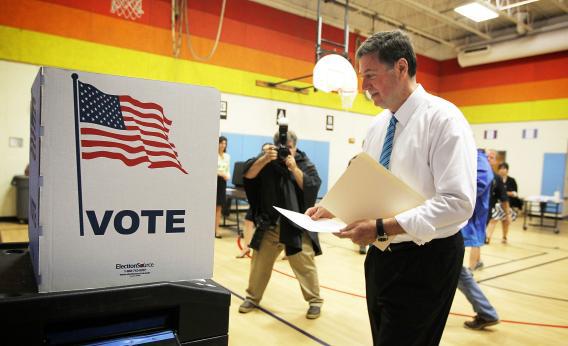When it begins showing ads Thursday that come close to calling Virginia Senate candidate George Allen a racist, the AFL-CIO’s new Workers’ Voice super PAC will be using new tools to focus old-fashioned outrage online.
Workers’ Voice is rotating four ads each attesting to a different case study in Allen’s alleged racial intolerance: one about his vote against honoring Martin Luther King Day, one each describing his use of a Confederate flag and a noose as interior-décor elements, and one declaring simply macaca—the nickname he used for an Indian-American tracker during his last Senate campaign. Viewers who click on one of the ads will be taken to a landing page where they will be allowed to vote on which “of these you think is the most deplorable of George Allen’s past actions.”
The design reflects Big Labor’s expanded post-Citizens United reach beyond merely communicating with union members and its desire to brand Workers’ Voice as a platform for a new crowdsourced approach to once-centralized tactical decisions like which ads to run. “Voting on them lets us get real-time feedback on which is working the best, which then we can use to change the traffic,” says Workers’ Voice communications director Eddie Vale. “If people think one of them is way worse, we’ll increase the frequency of that one in rotation.”
Above all, the $54,000 online buy exposes the extent to which ads delivered through individually identifiable online cookies may supplant direct mail as political communicators’ favorite channel for engaging preselected targets on provocative themes with little fear of mobilizing opponents. The ads will reach core Democratic constituencies—voters in Richmond and the Washington suburbs, along with African-Americans and Latinos statewide—in which Tim Kaine’s allies hope to increase interest and awareness of the Senate contest. It amounts to a universe of infrequent voters predicted to be uncertain to cast a ballot in the Senate race—an apparent tactic for fighting so-called “drop-off” among Democrats who turn out to vote for Barack Obama but may not yet be invested in the Senate race between two former governors.
These groups cover both union members and nonunion households, although the AFL has different methods of reaching each population. To assemble its own cookie pool of union members, the AFL gathers email lists of members and sends prospecting messages that draw recipients to a Web page where they can be identified and matched through the email address to a real-world name and address. The AFL profiles nonunion households through microtargeting models and has firm DS Political match its list of targets to individual cookies that can be used to serve them ads across a variety of networks. By requiring those who want to vote on the Allen ads to sign in with a name, email address, and ZIP code, Workers’ Voice will expand its own database of Virginia supporters reachable again through other channels.
